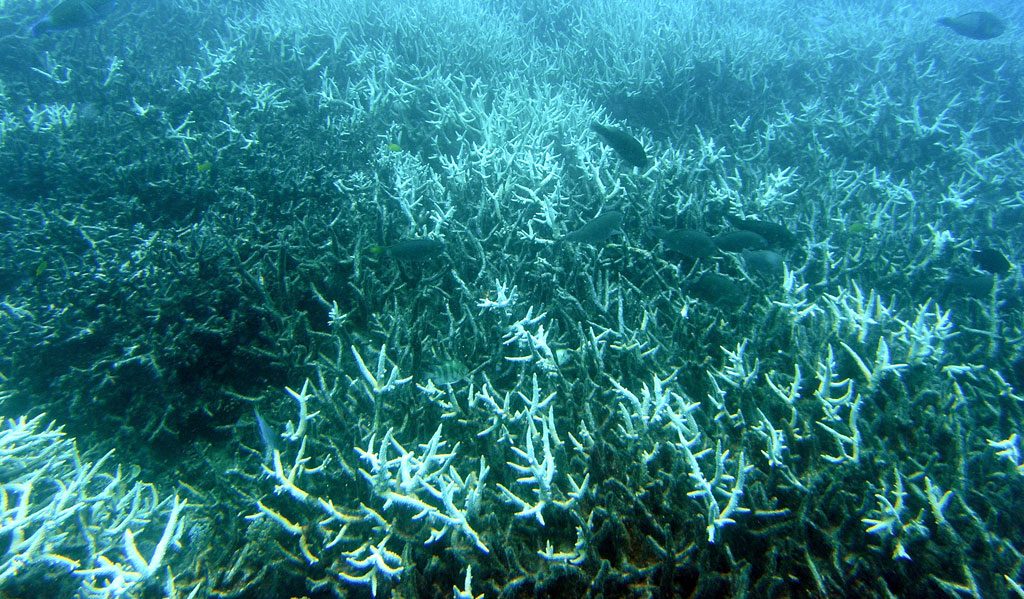Located in the western Pacific Ocean is a 6 million square kilometer coral area referred to as the Coral Triangle. This economic cornerstone is currently under threat, with grave implications for both the global community and the six countries it borders: the Philippines, Indonesia, Malaysia, Papua New Guinea, the Solomon Islands, and Timor Leste.
Corals have a symbiotic relationship with zooxanthellae algae; they need each other to survive. However, when there is a change in the oceanic environment, most often, a rise in temperature, the corals will reject the algae, turn white, and die. This phenomenon is known as coral bleaching.
Coral reefs are of immense importance for our oceans. The National Oceanic and Atmospheric Administration have reported that “about 25% of the ocean’s fish depend on healthy coral reefs because fishes and other organisms shelter, find food, reproduce, and rear their young in the many nooks and crannies formed by corals”. Their destruction would not only cause a major disturbance within marine ecosystems, but would also destroy the lives of those who rely on these coral reefs for various socio-economic reasons such as food, revenue, diving, tourism, and shore protection.
It is evident that humans have heavily contributed, and are still actively contributing to this environmental catastrophe. Pollution, waste disposal, overfishing, and climate change are a few of the most important reasons why coral bleaching is occurring. The World Wide Fund for Nature has stated that 85% of the corals within the Coral Triangle are directly under threat from human local activities. Moreover, the Intergovernmental Panel on Climate Change has claimed with high confidence that “multiple lines of evidence indicate that the majority (70–90%) of warm water (tropical) coral reefs that exist today will disappear even if global warming is constrained to 1.5°C,” further emphasizing the tragic fate that awaits the Coral Triangle.
The Philippines has been greatly affected by the disappearance of its coral reefs. As the only country located entirely within the Coral Triangle, it has the second-largest coral reef area, estimated at 27 000 square kilometers, and is comprised of around 7 000 small islands within the Coral Triangle. A total of 45% of its population lives on the coast, with an estimated 1.35 billion USD of the country’s GDP coming from activities such as fishing, tourism, and research. This demonstrates the country’s reliance on its environment and, therefore, the implications that the growing disappearance of Filipino coral reefs will have on local communities.
The socio-economic impacts would be especially grave for local fishermen, as well as towns by the sea. Local communities are reliant on fishing as a source of sustenance as they provide food and opportunities for trade. That being said, coral bleaching could cause fish populations to move into deeper waters, making fishing less accessible for local fishermen by the coast. These fishermen are already considered to be ‘among the country’s poorest,’ but as coral reefs and fish continue to disappear, their economic prospects are only looking bleeker.
Furthermore, “on average, a barrier reef cuts the power of a wave by 97%, protecting the coast and [its] communities.” Because the Philippines is known to be in an area where hurricanes occur, the reefs are essential barriers for the protection of the coast. An increase in coral bleaching could leave villages located by the sea vulnerable, with the potential of leaving many without a home. Moreover, this would cause a decrease in tourism which is reliant on the coral reefs. Notwithstanding the threat posed by tourism to the bleaching of coral reefs, local communities do not have decision-making power over these economic activities which are increasingly shaping the shorelines they live on. Tourism creates jobs and brings revenue for both local governments and entire families, so it is unlikely that the government will prioritize the environment over the economy.
Nonetheless, while the state of the coral reefs in the western Pacific Ocean seems alarming, there is still hope. Programs, as well as initiative agreements between governments, are slowly being implemented in an effort to limit the deterioration of the Coral Triangle. Notably, the Coral Triangle Initiative, created in 2007, aims to encourage local communities and governments to take care of their marine life and coastal resources by creating Marine Protected Areas (MPAs). It declared in 2018 that it was ‘the third International Year of the Reef (IYOR), a global effort to help raise awareness and urge conservation action on the world’s reefs’. The government has also tried to take control of the situation through their Coastal Law Enforcement, prohibiting bad fishing practices, such as the use of dynamite or cyanide. Additionally, it uses local government control on up to 15 kilometers of offshore coasts so that local communities can have the chance to play a greater part in preserving their coastal regions.
It is also important to note that there exists more optimistic outlooks regarding the future of the Coral Triangle, even in the absence of drastic change. Adaptation and acclimatization could potentially occur, meaning that, even if corals were to disappear, the surviving ones would still be able to reproduce and create a new, more resistant population of corals. Furthermore, coral selective breeding and cultivation are being looked into by scientists, though such methods need larger budgets.
Either way, if left unaddressed, coral bleaching will have drastic consequences for both coastal and international communities. Greater importance should be attributed to this environmental crisis, as it is already having important repercussions on coastal populations. Overfishing, waste disposal and, most importantly, global warming are part of the overarching climate urgency which needs to be mitigated in the shortest delays in order to avoid any further disturbances to marine ecosystems, including through increases in global sea temperatures.
Edited by Naya Sophia Moser
Photo credits: “Bleached coral” by Acropora. Published 21st of January, 2005. This work was sourced under a Creative Commons Attribution-Share Alike 3.0 Unported license. No changes were made.

